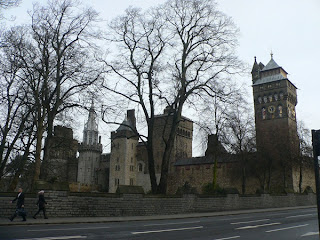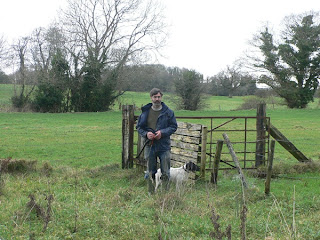The Caves of Kiltannon

Bill's birthday is the day after Christmas, always a bit of a gift-giving challenge. I was quite taken with this painting in the art gallery of our local library and decided to buy it for his birthday. When I met with the artist to make the cash-for-art transaction he explained that the bit that looks like a bridge is actually a natural stone arch.This is the River Kiltannon, which flows through a series of caves and natural arches about five miles from where we live.
When Bill opened his present I relayed what the artist had told me, and he immediately got out the Clare map and said 'Let's go find this place!' So we trudged across a flooded field to this hidden treasure.
 |
We were trying to figure out where the artist had done the painting - this stone arch looked the most similar to the one in the painting.
Some of the arches, like this one, aren't
very wide, but
there are other places where the river runs invisibly underground for long
distances. The scary thing in those sections are these occasional 'holes'
in the forest floor where you can see the river running about 20 ft. below the ground, so you really gotta watch where you step!
 We plan to go
back to Kiltannon this summer with our wellies on so we can walk from
one end of the river to the other through the caves.
We plan to go
back to Kiltannon this summer with our wellies on so we can walk from
one end of the river to the other through the caves. We also came upon an ivy-covered castle ruin near the river. My camera has been doing this weird thing with the purple background colour, but I've noticed that it only happens at historic or ancient sites.
For example, here is Bill right next to the castle. I took this photo just a few minutes after the one above. Spooky!
In Wales with the Kinfolk
On the first and only nice day in the Beacons, Bill, John and I walked to the top of Table Mountain. There's John at the top and Sugar Loaf mountain in the distance.
 |
| Another view of Table Top |
 |
| Weeping Beech |
 |
| At the Ironworks |
We spent one of the days walking around the old ironworks in the morning and touring an old coal mine in the afternoon, a perfect activity for the wet day.
This part of Wales was a heavy industrial area in the 1800's due to high concentrations of iron in the soil and vast seams of superior Welsh coal.
While iron and coal work was dangerous and dirty, it was paid work and it put food on the table. Although the topography and vegetation of Wales is very similar to Ireland, it was apparent that the country had never experienced the devastating poverty and famine that Ireland went through in that same time period. In Ireland you see ruins of abandoned cottages everywhere from the 1800's when the population decreased by 50% due to starvation and emigration. Many Irish emigrated to Wales for work in the mines, as evidenced at one of the ironworker's cabins that's wallpapered with old Cork newspapers.
While iron and coal work was dangerous and dirty, it was paid work and it put food on the table. Although the topography and vegetation of Wales is very similar to Ireland, it was apparent that the country had never experienced the devastating poverty and famine that Ireland went through in that same time period. In Ireland you see ruins of abandoned cottages everywhere from the 1800's when the population decreased by 50% due to starvation and emigration. Many Irish emigrated to Wales for work in the mines, as evidenced at one of the ironworker's cabins that's wallpapered with old Cork newspapers.
 |
| My camera was acting paranormal again at the ironworks. |
One of the highlights of our trip to Wales was a tour of 'Big Pit', the
big coal mine at Blaenevin that is no longer in use (most coal mining is done in China now). I wouldn't be big on going
underground, I far prefer the heights to the depths. But this
tour was well worth the slight claustrophobia I experience underground.
 This photo shows the entrance to the mine. The red structure on top is the wheeled mechanism that operates the mine shaft elevators with a system of counterweights. No cameras or other electronic devices are allowed inside the mine due to the danger of the batteries igniting mine gases, so this the only photo I took at Big Pit. (If we hadn't been so socked in with fog and mist that day you could see a nice view of hill and dale beyond the mine.)
This photo shows the entrance to the mine. The red structure on top is the wheeled mechanism that operates the mine shaft elevators with a system of counterweights. No cameras or other electronic devices are allowed inside the mine due to the danger of the batteries igniting mine gases, so this the only photo I took at Big Pit. (If we hadn't been so socked in with fog and mist that day you could see a nice view of hill and dale beyond the mine.)
The tours at Big Pit are given by retired coal miners who worked in the mines for decades - our guide introduced himself with 'I started working with me da in the mines when I was a lad of 16 and spent 40 years down here'. This really brings the tour to life.
I couldn't take any photos, but I found a great YouTube video with photos from coal mines in Kentucky, and backed by the haunting song Veins of Coal by the Horseflies.
Hearing the stories of hard and dangerous work in the mines, and not just by men but by women and children as well (children being small could get into the smaller seams of coal) was hard enough, but what really got to me was the story of the horses. Before they had electricity in the mines they used horses to pull the heavy carts of coal from the various passages to the central elevator shaft to be brought up to the surface. The horses lived, died and were buried underground and the horse stalls are still down below with the names of the last occupants on each stall - Lightning, Strider, Hercules.......
When the mines closed every summer for two weeks the horses were brought up above ground and turned loose in a pasture for their two week holiday. Our guide described how the horses were so delighted to be outside that they just frolicked and played the entire time. But at the end of the two weeks, he said 'the men had a divil of a time rounding those horses up again, for sure didn't the horses know that they had to go back down below for a whole 'nother year.' Sniff, sob.
 |
| We drove around the hills one day to this beautiful ruined abbey of gothic arches......... |

.........where the Carinis posed for their debut album cover.
 |
 |
| .......and tied to the nearby fairy tree. Those crazy pagans! |
We spotted a holy well, where people had left offerings and messages tucked into the stones around the well...
Something strange was going on at this little church on the hill
 | |||||
|
 | ||||||||
| We found a tiny stone shelter on the hill, complete with a miniature stone table and bench. |
 | |||||||||||||||
 |
| I like this sculpture of different types of seed pods. |
 |
| Random 'Ithaca' painted over someone's front door. |
County Tipperary

Back in Ireland, we found a new place to walk the dogs. This hill is in County Tipperary, across the lake from where we live in East Clare. That's Lough Derg in the background.

 |
| Testing the new Christmas wellies! |
 |
| Looking across Lough Derg to the Scariff Harbour (where we live), in the background. |





